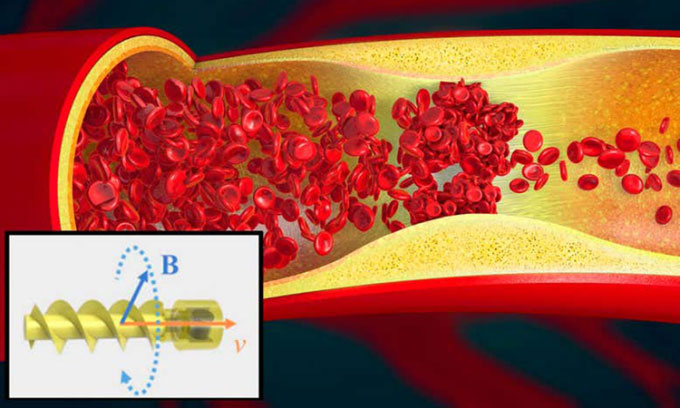Scientists Develop Tiny Robot Controlled to Deliver Drugs to Target Locations in Blood Vessels
In the future, blood clots may be cleared away by tiny drug-carrying robots swimming in blood vessels, reported Mail on January 11. The new study was published in the journal ACS Nano.

Illustration of a blood clot and a tiny spiral robot. (Photo: Christoph Burgstedt/Qianqian Wang/Xingzhou Du/Dongdong Jin/Li Zhang)
A team of engineers at the Chinese University of Hong Kong developed this robot inspired by the tails of bacteria such as E. coli. The tiny robot has a screw-like spiral shape. It is controlled by external magnetic fields and can move either with or against the flow of blood.
Experiments in a synthetic blood vessel containing pig blood showed that the robot made tissue plasminogen activator (used to dissolve blood clots) five times more effective than usual. The robot’s motor helps circulate the medication around the blockage, improving clot dissolution and reducing the risk of leaving behind large fragments. This risk arises when only medication is used and can lead to additional blockages downstream.
Since it is very challenging to control the robot over long distances within the body, the new method will be more suitable for blood clots located in easily accessible positions, according to the research team.
“The spiral robot acts like a pushing device, so it can transport goods from point A to point B. You can also have it perform other tasks beyond drug delivery, such as stem cell therapies or localized heating to destroy cancer cells,” said Li Zhang, a robotics expert at the Chinese University of Hong Kong and a member of the research team.
During laboratory testing, to monitor the robot’s operation in the synthetic blood vessel, Zhang and colleagues used Doppler ultrasound tracking, specifically measuring the reflection of sound waves transmitted through the blood.
The initial study has been completed, and the team of experts is looking for ways to conduct further tests with the tiny robots in more realistic environments. They will also strive to demonstrate that this robot can be safely used in patients’ blood vessels.


















































